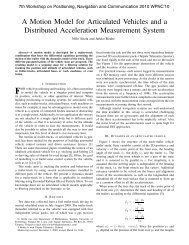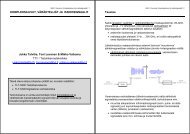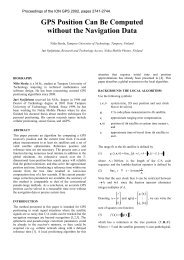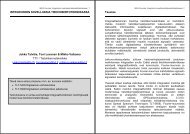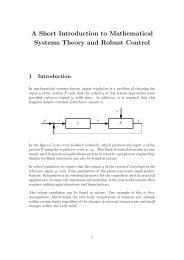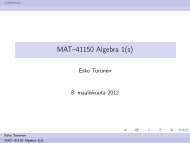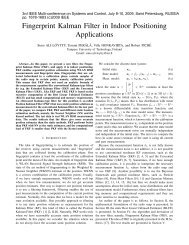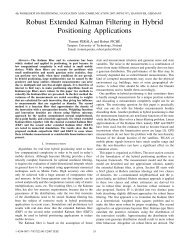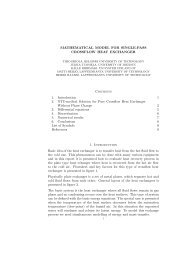Antti Lehtinen Doppler Positioning with GPS - Matematiikan laitos
Antti Lehtinen Doppler Positioning with GPS - Matematiikan laitos
Antti Lehtinen Doppler Positioning with GPS - Matematiikan laitos
You also want an ePaper? Increase the reach of your titles
YUMPU automatically turns print PDFs into web optimized ePapers that Google loves.
of the PRN codes is crucial because all the satellites transmit at the same frequency.<br />
The PRN codes are used to differentiate the satellite signals from each<br />
other. The PRN codes have been designed to have extremely low cross-correlation<br />
[<strong>GPS</strong> 1995]. With their wide spectra and low cross-correlations, the PRN codes<br />
are ideally suited for makingthe difference between the satellite signals. Systems<br />
like the <strong>GPS</strong>, which transmit different data at the same frequency, are called code<br />
division multiple access systems.<br />
The satellites transmit also navigation data which is modulated to the C/A signal<br />
at 50 Hz frequency. The navigation data is organised in superframes, frames and<br />
subframes. The superframes, frames and subframes last 12.5 minutes, 30 seconds<br />
and 6 seconds, respectively.<br />
The navigation message contains for example the ephemeris. The ephemeris is a<br />
set of time varyingparameters that are used to calculate the position and velocity<br />
of the satellite. The satellite positions can be computed accurately or approximated<br />
[Korvenoja & Piché]. The knowledge of satellite’s position is crucial for<br />
the positioning, as can be seen from the Figure 3.1. If the satellite position is<br />
biased, also the receiver position will be incorrectly determined. The ephemeris<br />
contains also some correction terms that pass the user information for example<br />
about the satellite clock drift.<br />
One of the most important things that the navigation data contains, is the time.<br />
The time in the navigation message is the time of transmission of the beginning<br />
of each subframe. Thus, the time information is sent in the navigation message<br />
once in 6 seconds.<br />
3.2.4 Pseudorange and Delta Range<br />
Above, the <strong>GPS</strong> was stated to be a time-of-arrival positioningsystem. The way<br />
to measure the propagation times of the signals is based on the PRN codes.<br />
The satellite PRN code is replicated in the receiver. Retardingthe replica code<br />
and performinga correlation process <strong>with</strong> the received signal yields △ti, the<br />
signal propagation time from the ith satellite. This can be obtained because the<br />
user knows both the time of the beginning of each subframe from the navigation<br />
message and the time of signal reception from the correlation process. The <strong>GPS</strong><br />
signals travel at the speed of light c. Thus, the satellite-to-user range can be<br />
computed <strong>with</strong><br />
ri − ru = c△ti<br />
(3.1)<br />
where ri is the satellite position vector, ru is the receiver position vector, c is the<br />
speed of light and △ti is the signal propagation time.<br />
10




